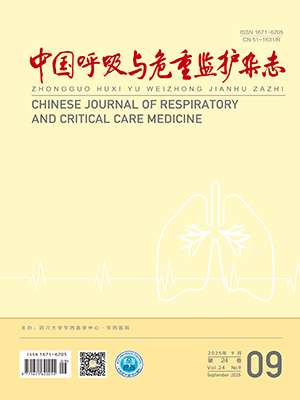Objective To investigate the changes of respiratory mechanics in response to elevated respiratory central drive and their impacts on the inspiratory signals detection.
Methods 10 normal volunteers were recruited for the study from the colleagues of the State Key Laboratory of Respiratory Disease. Rebreathing method was used to increase the end expiratory PCO2 ( PCO2 -ET) to the subject’s maximal tolerance in order to stimulate the increase of respiratory central drive. The changes of respiratory mechanics in response to elevated respiratory central drive and their impacts on the initiation signals of inspiration were observed.
Results After re-breathing, the average maximal tolerated PCO2 -ET was ( 81. 2 ±6. 6) mm Hg. As the PCO2 -ET rising, electromyogram of diaphragmatic muscle ( RMSdi ) ,transdiaphragmatic pressure ( Pdi ) and tidal volume ( VT ) increased progressively while the time of respiratory cycle ( Ttot ) shorten gradually. As the PCO2 -ETlevel increased frombaseline [ PCO2 -ET( level-0) ] to the maximal level [ PCO2 -ET( level-4) ] , RMSdi increased from( 17. 17 ±12. 41) μV to ( 147. 99 ±161. 64) μV,Pdi and VT increased from ( 7. 5 ±1. 7) cmH2O and ( 0. 68 ±0. 27) L to ( 26. 13 ±11. 51) cm H2O and ( 2. 21 ±0. 37) L respectively, while Ttot shorten from ( 2. 91 ±0. 85) s to ( 1. 92 ±0. 39) s. These four parameters of respiratory mechanics, RMSdi, Pdi, VT and Ttot, were highly correlated linearly with PCO2 -ET ( r value was 0. 956, 0. 973,0. 956 and 0. 89 respectively, all P lt;0. 001) . At the start of inspiration, the first detectable signal was electromyogramof diaphragmatic muscle ( RMSdi) , followed by mouth pressure ( Pm)and inspiratory flow ( Flow) on time sequence. As the rising of PCO2 -ET, the time lag of Pmand Flow from RMSdi after the initiation of inspiration increased gradually. However, the time lag between Flow and Pm remained constant.
Conclusions At the start of inspiration, the signal of RMSdi appears first as compared with Pm and Flow. As the rising of PCO2 -ET, the time lag of Pmand Flow fromRMSdi after the initiation of inspiration increased gradually, suggesting RMSdi is more sensitive inspiratory signal, which might be used for triggering of ventilator in order to improve the synchronization, especially in the situation of elevated respiratory central drive.
Citation: LIN Jianlian,ZHENG Zeguang,ZHONG Haibo,ZENG Yu,WANG Dexi.. Changes of Respiratory Mechanics in Response to Elevated Respiratory Central Drive and their Impact on Initiation Signal of Inspiration in Normal Adult Volunteers. Chinese Journal of Respiratory and Critical Care Medicine, 2013, 12(2): 141-145. doi: DOI: 10 . 7507 /1671 -6205 . 20130033 Copy
Copyright © the editorial department of Chinese Journal of Respiratory and Critical Care Medicine of West China Medical Publisher. All rights reserved




